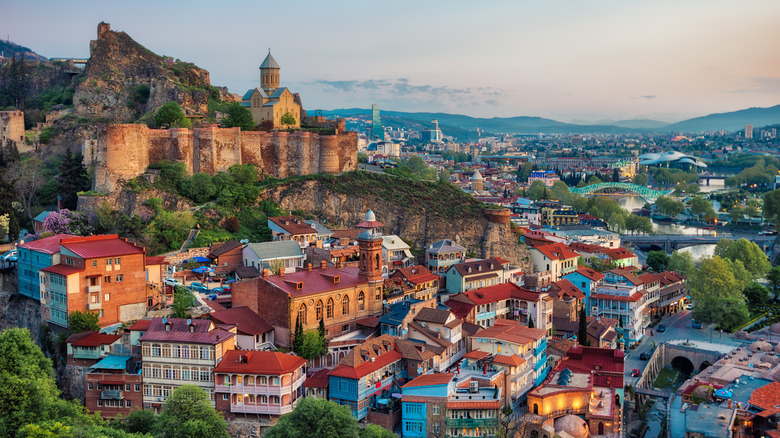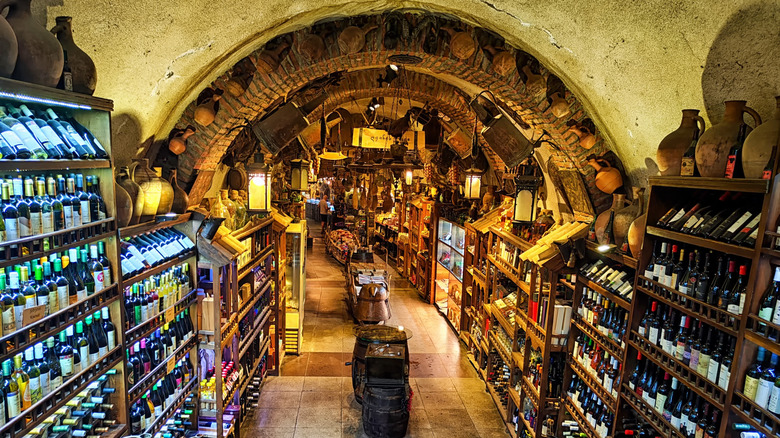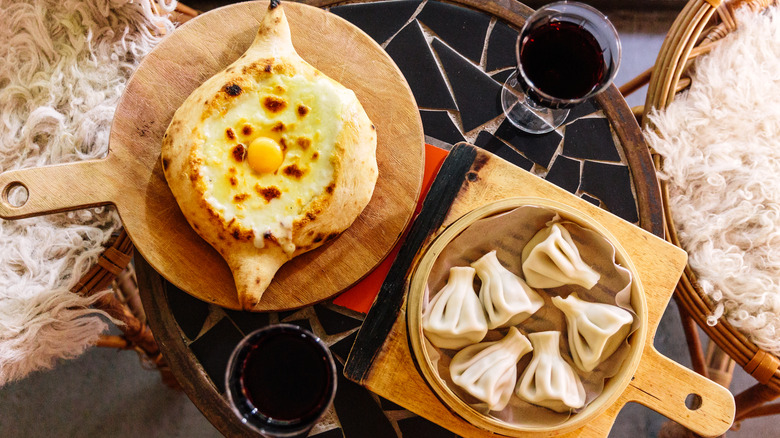Europe's Underrated, Wildly Affordable Capital Has The Oldest Wine Culture In The World And Bohemian Charm
Think wine, and your mind likely dances to the lush valleys of France or rolling hills of Tuscany. With oenophilic cultures stretching back 4,000 years, and modern-day industry dominance, you'd be forgiven for assuming wine originated in either country. But it's one of Europe's most underrated wine regions that claims the title of the "Cradle of Viticulture." And its capital, a wildly overlooked city bursting with bohemian charm, is the perfect place to discover it.
Tbilisi, the capital of Georgia, is spectacular. Strung across, between, and over a craggy valley in the southern region of the Caucasus Mountains, its peculiar blend of East and West is unlike anywhere in Europe. From 6th-century churches and 1,000-year-old Persian fortresses to neo-classical Parisian townhouses and brutalist communist factories, its complex history is scrawled across the cityscape. Its culinary scene is equally influenced by the countless empires that have swept through the region, as well as its strategic location on the Silk Road. Khachapuri, a euphoria-inducing cheese bread, may have been influenced by the Romans, while khinkali, fist-sized soup dumplings, are possibly tied to the Mongols.
Its greatest export, however, is its wine. Grape cultivation and fermentation have existed in Georgia for 8,000 years, predating most other regions by almost two millennia. It's a practice that continues today, combining modern methods with the traditional technique of qvevri aging. The grapes are placed in clay pots and buried underground, imparting rich notes on red wines and producing a bold, amber colored wine when using white grapes. Tbilisi's countless wine bars and tasting rooms are the best place to sample these at a fraction of the prices found in Italian or French wineries.
Wine tasting and exploring history in Tbilisi
Any visit to Tbilisi should finish with a glass of Saperavi or amber wine. Places like Sulico are an excellent choice. Most boast strong wine cellars and knowledgeable staff to help pair the local wines with some of the best cheeses or even larger meals. Head to Wine Not? for a full-blown tasting experience that highlights the different styles. To enjoy a broader understanding, there are countless tours from the city to the Kakheti wine region. Whatever you opt for, just be careful. At as little as $2 a glass or $10 a bottle, the easy-drinking wine can disappear quickly.
Explore the city, starting with a walk to Narikala Fortress. The old Persian citadel offers the best views of Tbilisi. Afterward, head through the patchwork streets to the Old Town, where the traditional Cauacus architecture gives way to Beaux-Arts townhouses from the early 20th century. Reminiscent of Paris, the area was once a hub of writers, scientists, and thinkers, before Stalinism took hold later in the century. After all the walking, relax at the Tbilisi Baths. The city was built on sulfur hot springs, with the 17th-century bathhouses today offering private and public experiences.
The Georgian National Museum is a chance to grasp the country's long history. While seeing the influence left by dozens of empires is wonderful, the sobering exhibit on the Soviet Occupation steals the show and highlights the country's current push towards European Union membership. Down the road, you'll find the Dry Bridge Market, a flea market with a dazzling variety of bric-a-brac. The true joy of Tbilisi, however, is exploring. With so many quirky corners, unexpected cultural scenes, and a tremendous selection of bars and restaurants, multiple visits can be just as rewarding.
Reaching Tbilisi and enjoying the local cuisine
Tbilisi's airport is adding new destinations every year, making it easier and easier for new travelers to discover its riches. It's a 20 to 25-minute drive to the center of the city, and can be done cheaply using a ride-hailing app like Bolt. You should use apps for the same reason tourists visiting Paris might want to completely avoid taxis — they will overcharge visitors. Tbilisi itself is pretty walkable, and driving through the smaller streets can be stressful, so it's best not to bother renting a car unless you're heading out to experience the rest of Georgia, one of Europe's most beautiful mountainous regions.
Accommodations range from traditional guesthouses in the Old Town area to big brand names like Hilton. For something truly unique, try staying at Rooms Tbilisi. Set in the bones of a renovated Soviet printing factory, the hotel offers stunning city views, bohemian luxury, and a unique setting to boot. The restaurant downstairs is outstanding, too. It'll be a little more expensive than other options, but the most affordable room will still fall below $120 a night on most dates.
As for eating, come prepared with loose pants. There are hundreds of outstanding eateries, from khachapuri stalls on the side of the road to full-blown Georgian taverns offering feasts with live traditional music. Pasanauri is a local and tourist favorite, offering all the classic Georgian dishes, while specialty restaurants like the Khinkali House offer unique takes on the city's favorite dumpling. Try as much as you can, and don't forget to wash it down with the local wine.


